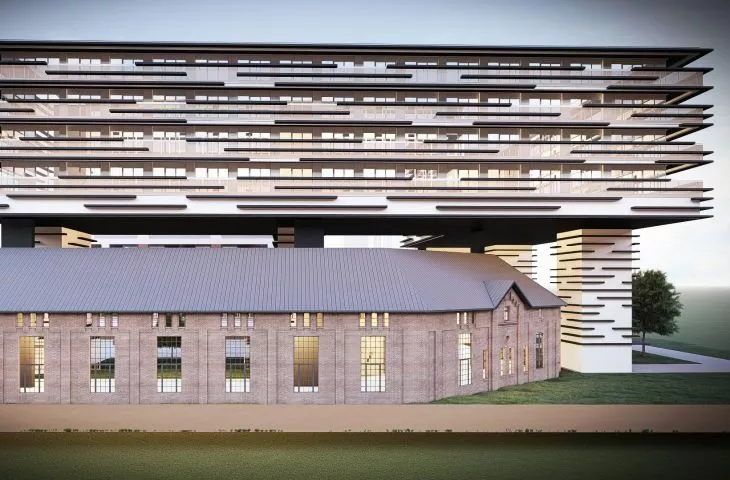Respecting a historic building, finding a new function for it, unifying development in the area and giving it a coherent character - this sounds like the ideal approach to new developments in conjunction with the historic fabric. However, even such laudable ideas are worth little without good design.
Kępa Mieszczanska in Wroclaw is an island located in the western section of the city's Odra River. It developed vigorously in the 17th and 18th centuries, when infrastructure related to the river was built there: ports, warehouses and mills. Its current shape is primarily the result of 19th and 20th century redevelopment, when most of the port and industrial buildings were removed and given an urban character. Today, this attractive location is often the site of new residential developments.
The proposed development on Kępa Mieszczanska
© ATC Development press materials
a monument in the shade
A new development will be carried out there by ATC Development. On the plot intended for construction there is a historic building of the former artillery barracks, which is under the conservation supervision of the Lower Silesian Provincial Conservator of Monuments. The investor agreed with the DWKZ on the scope of work and method of adaptation of the historic building and received a positive opinion. Indeed, the new building does not interfere with the historic structure, but only creates a characteristic superstructure over the building. The press release reads:
Modern architecture presents a number of positive examples of bold revitalization of historic buildings and spectacular results of cooperation between municipal and conservation authorities and investors. As examples, it is worth mentioning HafenCity - a newly built district in the port of Hamburg, or Krakow's Cricoteka. We are all the more pleased by the openness and positive opinion of our project issued by the Provincial Conservator of Monuments.
Former barracks on Kępa Mieszczańska in Wrocław
© ATC Development press materials
good example is not enough
It is impossible to disagree with this statement. In fact, many successful examples of a good combination of historic fabric and modern architecture are known. The aforementioned Cricoteka imposes itself, as the proposed realization is confusingly similar to it. Only much worse. The superstructure in no way corresponds to the artillery barracks, and is also unnaturally scaled back from the historic building. After seeing the visualization, the comparison to Cricoteka seems inappropriate. The positive opinion of the AGCC is not an argument in this regard, as it concerns the approach to the historic building, not the quality of the new architecture.
Unfortunately, the name of the author or the name of the design studio behind this visualization remains a mystery. The developer refused to provide the editors with this information.




































